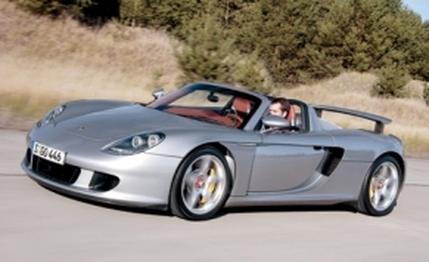
 First Drive Review
First Drive Review
It's not the $440,000 Carrera GT's absurdly fast top speed that awes you-we were aboard yet had no fear as Porsche's test driver clocked 208 mph (with a tailwind) on a Soviet-era military runway in the former East Germany.
It's not this Ferrari Enzo fighter's equally absurd accelerative force, either: Porsche modestly claims a 0-to-62-mph time of 3.9 seconds, but it's probably more like 3.5 seconds.
It's not even the otherworldly strength of the gigantic ceramic brakes that made the greatest impression on us, although they are strong enough at full clamp to lift the passenger fully away from his leather-covered, carbon-Kevlar seat and hard against the locked seatbelt.
No question-all these feats are stratospherically impressive. But they are just extensions of what you've felt before in a common automobile. These figures don't reveal the character of the Carrera GT any more than one's familiarity with hops, barley, and water explains how they can make you drunk.
Porsche says it will build 1500 of these supercars over the next three years. The Carrera GT, which began life as a proposal for a Le Mans race car, is nothing if not uncommon. In truth, it's not even a car, really. It's not like those things we put in comparison tests and rate the ergonomics and measure the gas mileage of-all those conveyances that operate in the vast gray center of the performance spectrum. The 604-hp Carrera GT is different. It's all vibrancy and immediacy.
It was actually turning off the ignition after our brief initial drive that first amazed us. The millisecond the ignition circuit is broken, there is . . . nothing. Normally, when you key the ignition off, the crankshaft makes a few extra lazy rotations as the mass of the moving parts takes a half-beat to submit to friction and come to a complete rest. It's a universal experience we take for granted.
But in the GT, the crankshaft stops with a new suddenness-immediately, now, before your brain even considers the causal relationship between turning the key and the engine coming to rest. It's as if the crankshaft had seized within a quarter-rotation after the last spark plug fired. There is no mass at all to speak of in the drivetrain. Take, for example, the lightweight ceramic clutch (measuring a mere 6.7 inches in diameter) and the 10 titanium connecting rods in this 68-degree V-10. They weigh, by regular commodity-car standards, essentially nothing. After a romp in the GT, whatever you drive will feel as if it were powered by a huge diesel-the kind we imagine powering ocean liners-with 10-foot-long iron connecting rods.
This works, of course, in reverse, too. Unlike the brawny powerplant of, say, a Lamborghini Murciélago or Dodge Viper, which pummels physics into submission, the Porsche's race-bred V-10 seems to skirt physics entirely. It always feels unrestrained. Here again we can thank low rotational mass. The best production-car engines in the world accumulate revs in a satisfyingly smooth sweep. So quick to rev is the 5.7-liter Porsche engine that you scarcely are aware that it's putting forth any effort at all. A stab of the wide, floor-mounted gas pedal and-Brip!-you're at the 8000-rpm power peak. Watch the in-car footage of an F1 car going up through the gears with its brief, staccato blasts through the revs, then slow the footage down by about half, and you get the idea.
This audiovisual trick will also roughly approximate the sound the GT makes. It's similar in timbre to an F1 motor but brawnier because of its greater displacement. Its note is a register lower because it runs fewer revs, and of course, it won't pierce your eardrums-there's a muffler. There is no time to adjust your mind-set between the docility of idle and the full-on, screaming fury of redline. Holy crap! Not even the standard traction-control system can keep up.